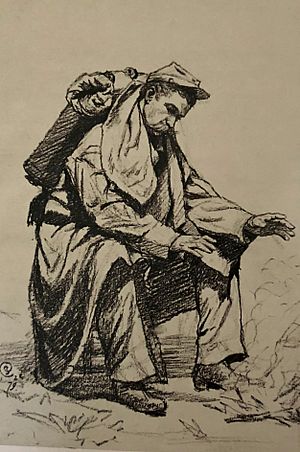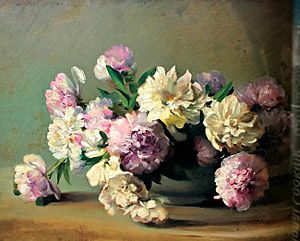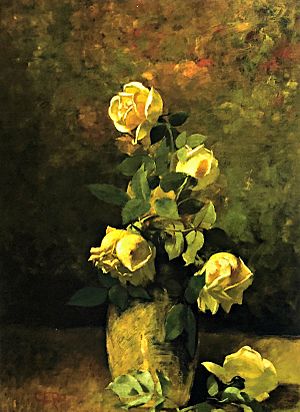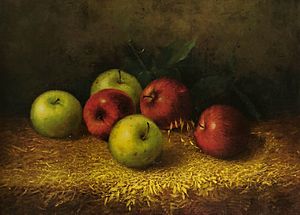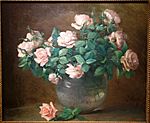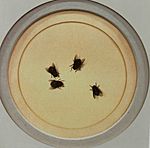Charles Ethan Porter facts for kids
Quick facts for kids
Charles Ethan Porter
|
|
|---|---|
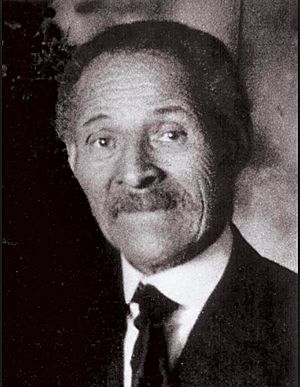 |
|
| Born | 1847 |
| Died | March 6, 1923 |
| Nationality | American |
| Education | National Academy of Design Ecole des Arts Decoratifs |
| Occupation | Visual artist |
| Known for | Still life painting |
|
Notable work
|
Untitled (Cracked Watermelon), Metropolitan Museum of Art |
Charles Ethan Porter (1847 – March 6, 1923) was an American painter. He was especially known for his amazing still life paintings. A still life painting shows objects like fruit or flowers.
Charles Porter was one of the first African Americans to show his art at the National Academy of Design in New York City. He was also the only African-American artist around the year 1900 who focused on still life art.
Contents
Early Life and Art School
Charles Porter was probably born in 1847 in Hartford, Connecticut. His family moved to Rockville when he was young. They faced many challenges during his childhood.
His brothers, Joseph and William, joined the Union Army in 1863 during the American Civil War. Sadly, Joseph died in Virginia in 1864. William became very sick but survived.
Charles was the first in his family to finish high school, graduating in 1865. In 1868, he left Rockville to study painting in Wilbraham, Massachusetts. Even though he was Black, he was accepted into Wesleyan Academy.
In 1869, Porter joined the famous National Academy of Design in New York City. He was the first African American ever admitted to this school!
He studied art there until 1873. During this time, he started showing his paintings. One of his artworks, Autumn Leaves, was shown in a school exhibition. The New York Times even mentioned his drawings in 1870.
Charles Porter gained a lot of praise for his art. Important people like the painter Frederic Edwin Church and the famous author Mark Twain supported him. Mark Twain lived in Hartford at the time.
Becoming a Professional Artist
After art school, Porter studied with Joseph Oriel Eaton, a well-known portrait and landscape painter. Every year, Porter would paint and study in New York City during the cooler months. In the summer, he would return to Rockville to paint and teach art classes.
Between 1873 and 1875, Porter began selling his artwork. One painting sold for $175, which was a lot of money back then!
In 1878, Porter moved to Hartford, Connecticut and opened his own art studio. Hartford was growing, and many wealthy people there loved art. Porter had a strong art education, which made him stand out. He was one of the few artists, and the only man, in Hartford who focused on still life paintings.
He created many of his famous still life paintings in Hartford. His paintings of fruit were special because they didn't always include fancy dishes. He sometimes added unusual touches like insects. His apple paintings were very popular, and he painted apples for many years.
Porter loved nature and spent a lot of time outdoors. This showed in his paintings of butterflies, birds, and plants. In 1879, the famous landscape painter Frederic Edwin Church noticed Porter's work. Church bought some of his paintings and said Porter was one of the best "colorists" in the United States.
Church encouraged Porter to paint landscapes too. In 1880, Porter spent two months sketching and painting in the Adirondack Mountains. He decided then that he would mostly paint landscapes, except for still life paintings that people asked him to do.
In 1881, a newspaper reported that Porter planned to move to Europe to study art for two years. He sold all his paintings to pay for the trip. He sold about $1800 worth of art, which was a large sum!
In November 1881, Porter sailed to Liverpool, England. After seeing art in London, he went to Paris, France. He had letters of introduction from important people in Hartford, including Samuel Clemens.
In Paris, he studied the works of artists from the Barbizon school of painting. He also enrolled in the Ecole des Arts Decoratifs. He studied there until 1884, when he ran out of money and returned to Hartford.
In December 1884, he held an art show and auction of 100 paintings he made in France. His new work was praised, but the auction didn't bring in as many sales as he hoped.
In 1885, Porter moved back to New York City and opened a studio. He continued to paint and show his work at the National Academy of Design. He spent summers in Rockville, Connecticut, teaching art and painting landscapes.
By 1889, Porter had left Hartford for good. He spent most of his time in New York City and summers in Rockville. In 1897, he settled permanently in Rockville. After 1900, the quality of his work changed, and people became less interested in his art. Charles Porter passed away on March 6, 1923, at 75 years old.
Legacy and Recognition
People started to become interested in Charles Porter's art again in the 1980s. The first museum show featuring his work opened in 2008. This show was put together by the New Britain Museum of American Art.
Today, his paintings are part of important public collections. You can find his art in places like the Metropolitan Museum of Art, the Smithsonian American Art Museum, and the Wadsworth Athenaeum.
Images for kids
Image gallery
See also
 In Spanish: Charles Ethan Porter para niños
In Spanish: Charles Ethan Porter para niños


